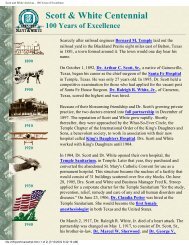Styles of Grief - Healthcare Professionals
Styles of Grief - Healthcare Professionals
Styles of Grief - Healthcare Professionals
Create successful ePaper yourself
Turn your PDF publications into a flip-book with our unique Google optimized e-Paper software.
<strong>Styles</strong> <strong>of</strong> <strong>Grief</strong><br />
The Instrumental – Intuitive<br />
Continuum<br />
Kenneth J. Doka, PhD<br />
Pr<strong>of</strong>essor, The College <strong>of</strong> New Rochelle<br />
Senior Consultant, The Hospice Foundation <strong>of</strong><br />
America
Three Major Goals<br />
• To Discuss and Differentiate Grieving<br />
<strong>Styles</strong> (Martin & Doka)<br />
• To Apply the Concept <strong>of</strong> Grieving <strong>Styles</strong> to<br />
Family Systems<br />
• To Explore Implications for Counselors
Biography <strong>of</strong> a Concept I<br />
• Father’s Death<br />
• CPE<br />
• Dennis Ryan’s chapter in Disenfranchised<br />
<strong>Grief</strong>
The Myth <strong>of</strong> Men and <strong>Grief</strong><br />
• Emotionally Unexpressive<br />
• Unable to Relate
Simply put there is only one<br />
way to grieve. That way is to<br />
go through the emotional core<br />
<strong>of</strong> grief. Only by exploring the<br />
necessary emotional effects <strong>of</strong><br />
your loved one’s death, can<br />
you eventually resolve grief<br />
Staudacher, Men and <strong>Grief</strong>
The Myth <strong>of</strong> Men and <strong>Grief</strong><br />
Not supported in theory, clinical<br />
practice or research
A Brief Review<br />
<strong>Grief</strong> 101
A Brief Review<br />
<strong>Grief</strong> 101
<strong>Grief</strong> is manifested in many<br />
ways<br />
• Physically<br />
• Emotionally<br />
• Cognitively<br />
• Behaviorally<br />
• Spiritually
<strong>Grief</strong> is a very individual<br />
reaction<br />
The need to assess
The <strong>Grief</strong> Process<br />
A Roller Coaster <strong>of</strong> Reactions
Stroebe and Schut<br />
Dual Process Model<br />
• Calls for Oscillation<br />
between<br />
– Loss-Oriented<br />
Processes<br />
– Restoration Processes<br />
• Thompson notes how<br />
each pattern<br />
(especially at<br />
extremes) can inhibit<br />
oscillation
<strong>Grief</strong> is not a time bound<br />
process that ends in<br />
detachment
Amelioration <strong>of</strong> <strong>Grief</strong><br />
• Over time pain lessens<br />
• Persons function at similar (or sometimes<br />
better levels) than prior to the loss<br />
• Yet, grief still has a developmental aspect
The Tasks <strong>of</strong> <strong>Grief</strong><br />
• Acknowledge the loss<br />
• Express manifest and latent emotion<br />
• Adjust to a changed life<br />
• Relocate the loss<br />
• Reconstitute faith and philosophical<br />
systems challenged by the loss<br />
Worden (Modified)
Biography <strong>of</strong> a Concept II<br />
• Martin & Doka – ADEC Paper “Take It<br />
Like a Man”<br />
• Nichols<br />
• Masculine Vs. Feminine/Conventional
Advantages <strong>of</strong> Masculine<br />
• Theoretical Value<br />
• Related to Gender<br />
• Challenge Concept that Men Were<br />
Ineffectual Grievers
Disadvantages <strong>of</strong> Masculine<br />
• Confusion with Gender<br />
• Perpetuates Stereotypes<br />
• Difficulties <strong>of</strong> Gender Based Terminology
Intuitive vs. Instrumental
Grieving <strong>Styles</strong> Exist along a<br />
Continuum
Grieving <strong>Styles</strong>: An Alternate<br />
Visualization
Intuitive <strong>Grief</strong><br />
• Experiences Strong Affective Reactions<br />
• Expression Mirrors Inner Feelings<br />
• Adaptation Involves Expression and<br />
Exploration <strong>of</strong> Feelings
Instrumental <strong>Grief</strong><br />
• Experience <strong>of</strong> <strong>Grief</strong> Is Primarily Cognitive<br />
or Physical<br />
• <strong>Grief</strong> Often Is Expressed Cognitively or<br />
Behaviorally<br />
• Adaptation Generally Involves Thinking<br />
and Doing
Instrumental <strong>Grief</strong><br />
• “Most contemporary<br />
Western philosophies<br />
with the possible<br />
exception <strong>of</strong><br />
empiricism, can be<br />
understood as<br />
instrumental ways to<br />
encounter death, loss,<br />
and grief” D. Klass
A Question<br />
When instrumental grievers are “doing”<br />
their grief, how conscious does the<br />
connection to the deceased need to be<br />
• We believe that the<br />
connection does not have<br />
be fully conscious though<br />
there <strong>of</strong>ten is a connection<br />
• It should be accessible and<br />
consistent with the way<br />
the energy generated in<br />
grief is experienced by the<br />
person involved
• Smith suggests that<br />
Shakespeare’s way <strong>of</strong><br />
dealing with his grief<br />
over the death <strong>of</strong> his 11-<br />
year-old son, Hamnet,<br />
was to process his grief<br />
in his subsequent plays<br />
• His contemporary, Ben<br />
Johnson, composed<br />
moving elegies to his two<br />
deceased children<br />
Men’s <strong>Grief</strong>
Blended Grievers<br />
• Share experiences,<br />
expressions and adaptation<br />
strategies <strong>of</strong> both intuitive<br />
and instrumental grievers<br />
• Will <strong>of</strong>ten have varied<br />
experiences and use<br />
strategies depending on<br />
the relationship to the<br />
deceased, the situation<br />
experienced, and the time<br />
since the loss
Dissonant <strong>Grief</strong><br />
Discontinuity in Experience vs.<br />
Expression
Oregon Center for Applied<br />
• Heart Grievers<br />
• Head Grievers<br />
• Head + Heart<br />
• Head vs. Heart<br />
Science<br />
Ways <strong>of</strong> Portraying Model
Grieving <strong>Styles</strong> Are Influenced<br />
• Gender<br />
– Biological<br />
– Cultural<br />
– Affected by change in<br />
gender roles<br />
• Culture<br />
• Temperament<br />
• Other<br />
By
Grieving <strong>Styles</strong> in the Life<br />
• While there is likely to<br />
be consistency in a<br />
grieving styles, they<br />
can change<br />
• During the life cycle<br />
some movement<br />
toward the poles in<br />
adolescence and<br />
toward the center in<br />
later life is not unusual<br />
Cycle
Differences – Not Deficiencies
These <strong>Styles</strong> Exist as General<br />
Adaptive Patterns and Can Be<br />
Seen in Other Circumstances<br />
including the Illness<br />
Experience
Each Style Has Its Own<br />
Advantages and<br />
Disadvantages
• With Intuitive – the<br />
problem <strong>of</strong> overwhelming<br />
potential support<br />
• The Paradox <strong>of</strong> Support<br />
• Widowers with strong<br />
social support fared well<br />
(Silverman & Campbell)<br />
• With Instrumental – the<br />
problem <strong>of</strong> premature<br />
problem-solving<br />
• Alcohol and substance<br />
abuse – the different<br />
reasons persons abuse<br />
substances<br />
Grieving <strong>Styles</strong>
Allen & Hayslip (1990)<br />
Model <strong>of</strong> Experienced Competence<br />
• Significant loss will<br />
necessitate the<br />
reconstruction <strong>of</strong> one’s<br />
assumptive world<br />
• Persons thus need a sense<br />
<strong>of</strong> control and a belief that<br />
they can do this<br />
reconstruction<br />
• Active coping emphasized<br />
in their model – thus value<br />
<strong>of</strong> an instrumental<br />
approach
What about androgynous<br />
approaches<br />
• Schut’s research supports the idea that:<br />
– Men valued from affective approaches<br />
– Women valued from more cognitive<br />
approaches
Disadvantages <strong>of</strong> Androgyny<br />
• Research was based on gender<br />
• Double burden <strong>of</strong> androgyny<br />
• Crisis is a poor time to teach new adaptive<br />
skills
Support for Grieving <strong>Styles</strong><br />
• Theory<br />
– <strong>Grief</strong> Reactions and Adaptation<br />
– Coping Literature<br />
– Emotion Regulation<br />
• Research<br />
– Gender (Law <strong>of</strong> Social Physics)<br />
– Bonanno, Nolan-Hoeksema<br />
– Rosenblatt – Cross-Cultural Research<br />
• Clinical Practice<br />
– Rando<br />
– Stillion & McDowell
Research<br />
Gender Differences in Morbidity and Mortality in<br />
Widowhood<br />
• A meta-analysis by Stroebe,<br />
Stroebe, and Schut (2001) indicated<br />
that while evidence is mixed, they<br />
determined that men have higher<br />
rates <strong>of</strong> morbidity (including<br />
mental health) and mortality in<br />
widowhood<br />
• See some explanation in buffering<br />
hypothesis – women are more open<br />
to social support and note, as yet<br />
unsupported idea that emotional<br />
coping assists<br />
• Suggest that factor may be that<br />
gender constraints can inhibit<br />
individuals in dealing with the dual<br />
processes <strong>of</strong> bereavement
Adaptive Grieving <strong>Styles</strong><br />
• Doughty (2009) in a<br />
Delphi study <strong>of</strong> experts<br />
found that there was<br />
consensus among<br />
experts on the major<br />
premises <strong>of</strong> the model<br />
• Humphrey (2009) in a<br />
book published by the<br />
ACA highlighted the<br />
model as a valued one<br />
for counselors
Warning!<br />
The Use <strong>of</strong> Models<br />
• Models are a tool to understand<br />
reality – they should not be<br />
confused with reality<br />
• Use models to the extend that<br />
they assist you or your client in<br />
understanding and responding<br />
to a problem<br />
• When they do not – use other<br />
models<br />
• “The Chicken George<br />
Principle” – When your plan<br />
does not work – get another<br />
plan!
Family Implications<br />
Four Dimensions
First Dimension<br />
Complementary Vs.<br />
Symmetrical
Second Dimension<br />
Isolate vs. Interactive
Third Dimension<br />
Respectful Vs. Conflicting
Differences in the Ways<br />
Family Members Grieve Are<br />
Not Differences in Love!
Thou Shall Respect Different<br />
Grieving <strong>Styles</strong>!
Fourth Dimension<br />
Typical Vs. Atypical<br />
(Culture and Gender)
Working With Families<br />
• Assess styles and<br />
dimensions<br />
• Challenge families to<br />
acknowledge differences –<br />
as differences<br />
– Illustrate effective models<br />
– Differences in coping and<br />
attraction<br />
– Challenge inappropriate<br />
judgments<br />
– Take responsibility to meet<br />
own needs
How Can Counselors Help
Begin with Self<br />
• Acknowledge Different Grieving <strong>Styles</strong><br />
• Recognize the Culture <strong>of</strong> Counseling (Sue<br />
& Sue)
Validate Grieving <strong>Styles</strong><br />
• Instrumental Grievers (especially early in<br />
the grief process)<br />
• Intuitive Grievers (later in the grief process)<br />
• Male Intuitive Grievers<br />
• Female Instrumental Grievers (the most<br />
disenfranchised)
Assess – Do Not Assume<br />
• Consistency in history<br />
<strong>of</strong> coping<br />
• Comfort in discussing<br />
loss<br />
• Sense <strong>of</strong> movement in<br />
grief<br />
• Assessment<br />
instruments
Counseling Approaches<br />
• Avoid the “F” Word<br />
• Use Eclectic Methods – including<br />
Expressive Approaches (intentionally)
Counseling Intuitive Grievers<br />
• Traditional Approaches<br />
Work Well<br />
• Individual Counseling Can<br />
Focus on Expressing and<br />
Exploring Affect (within a<br />
holistic framework)<br />
• Traditional Support<br />
Groups Can Help (within<br />
• a holistic framework)
Counseling Dissonant<br />
Grievers<br />
• Assess Pattern Carefully<br />
• Explore Factors Inhibiting<br />
Emotional Expression<br />
• Create a Safe<br />
Environment for<br />
Expressing Emotion<br />
• Carefully Led and<br />
Structured Support Group<br />
Can Work especially<br />
men’s groups
Counseling Dissonant Male<br />
• Assess developmental<br />
experiences and socialization<br />
experiences in family <strong>of</strong> origin<br />
that inhibited emotional<br />
awareness and expression<br />
• Create a safe, connected,<br />
equalitarian environment<br />
• Use self-disclosure and model<br />
emotional expression<br />
• Use action modalities – body<br />
movement, writing etc.<br />
• Strategies may include dosing<br />
and private expressions <strong>of</strong> grief<br />
Grievers
Counseling Dissonant Female<br />
Grievers<br />
• Assess developmental<br />
and socialization<br />
experiences that might<br />
inhibit emotional<br />
expression<br />
• Create a safe<br />
environment<br />
• Teach strategies <strong>of</strong><br />
dosing
Dissonant <strong>Grief</strong>: Case<br />
• Mark, normally a male who<br />
copes in a very affective way,<br />
now works excessively after his<br />
daughter’s death. He refuses to<br />
discuss his grief or daughter<br />
and claims it does no good to<br />
“wallow in the past”.<br />
• In counseling he expresses the<br />
fear that if he encounters his<br />
emotion, “the dam will burst”<br />
• In counseling addressed the<br />
idea that perhaps the dam has<br />
an overflow valve – the value <strong>of</strong><br />
dosing
• Assess<br />
Counseling Instrumental<br />
• Traditional Approaches<br />
May Not Work Well<br />
• Cognitive Therapies<br />
• Active Approaches<br />
• Therapeutic Metaphors<br />
(Carrying a heavy load<br />
etc.)<br />
• Psycho-educational<br />
approaches – especially<br />
the use <strong>of</strong> books and<br />
videos<br />
Grievers
Counseling Male Clients<br />
• While Levant et. al stress<br />
dysfunctional elements <strong>of</strong><br />
male ideology, other,<br />
more positive aspects can<br />
be utilized<br />
– Self-sacrifice<br />
– Protect the weak<br />
– Courage valued<br />
– “Take one for the team” –<br />
social responsibility and<br />
being a team player
Counseling with Instrumental<br />
Grievers<br />
• Use styles compatible<br />
with the male role<br />
such as storytelling<br />
• Recognize that men<br />
will move in and out<br />
<strong>of</strong> emotions – <strong>of</strong>ten<br />
using dosing and<br />
humor
Counseling with Instrumental<br />
• Rituals have had an<br />
important cultural and<br />
historical role with men<br />
– such as rites <strong>of</strong><br />
initiation<br />
• Rituals draw on the need<br />
to “do” and <strong>of</strong>fer<br />
elements <strong>of</strong> symbolic<br />
control<br />
• For example, building a<br />
c<strong>of</strong>fin for a dead cat<br />
with one’s son<br />
Grievers
Counseling with Instrumental<br />
Grievers<br />
• Reframing strengths<br />
• For example, men take<br />
pride in coping with<br />
hardship<br />
• “It might be tough to<br />
sit with your wife as<br />
she expresses pain –<br />
but that could be a<br />
helpful sacrifice”
Instrumental Strategies<br />
Cognitive<br />
• Logical Analysis –<br />
breaking the crisis down<br />
to manageable units<br />
• Logical restructuring –<br />
Benefit finding<br />
• Diversion/Cognitive<br />
Distraction<br />
• Information –Seeking<br />
• Humor
Instrumental Strategies<br />
Behavioral<br />
• Problem-Solving<br />
• Physical Activity<br />
• Spiritually-Focused<br />
Strategies
Instrumental Strategies<br />
Affective<br />
• Ventilation – in safe<br />
places<br />
• Affect Regulation –<br />
dosing<br />
• Indirect Ventilation<br />
– humor, music etc.<br />
• Remember – Pastels<br />
vs. Vivid Colors
Utilizing Media in Counseling<br />
• Application <strong>of</strong><br />
teaching methods<br />
• Value <strong>of</strong> the familiar<br />
to model or engage<br />
discussion<br />
• Illustration: Home<br />
Improvement – model<br />
<strong>of</strong> effective<br />
complementary styles,<br />
humor, and ritual
Illustration: Support Groups<br />
• Validation<br />
• Ventilation<br />
• Respite and Support<br />
• Learn Coping Techniques<br />
• Hope
Developing Groups for<br />
Instrumental Grievers<br />
• Whose needs are being<br />
met<br />
• The importance <strong>of</strong><br />
needs assessment
Traditional Models May Not<br />
Meet the Needs <strong>of</strong><br />
Instrumental Grievers<br />
• Adventure-Based Groups<br />
• Discussion and Reading Groups<br />
• Educational Seminars<br />
• Informal Groups (Sharing Wives’ Recipes)<br />
• Problem-Solving Groups (Parents without<br />
Partners)<br />
• Expressive Art Groups
• The Harvard<br />
Bereavement study<br />
suggested that fathers<br />
were best served by<br />
<strong>of</strong>fering a group on<br />
how to be good single<br />
parents – rather than<br />
<strong>of</strong>fering emotional<br />
support (Worden,<br />
2008)<br />
Men’s Groups
Innovative Ideas<br />
• <strong>Grief</strong> at the Bar<br />
• Chris Hall runs a<br />
men’s bereavement<br />
group that meets at<br />
a pub over pizza<br />
and beer
Comprehensive <strong>Grief</strong><br />
Programs<br />
Education<br />
Ritual<br />
Support
Counseling Approaches<br />
• Use Methods that<br />
Transcend <strong>Styles</strong><br />
– Journal Writing<br />
– Expressive Approaches<br />
– Therapeutic Ritual
The Possible Paradox<br />
• Instrumental Grievers Attraction to the<br />
Field<br />
• The Culture <strong>of</strong> Counseling

















